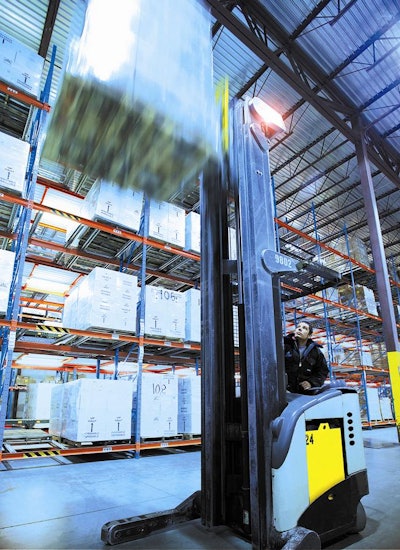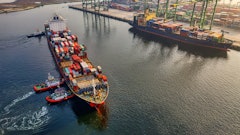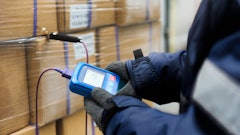
This fickle and unpredictable economy is no one’s friend these days, not even public refrigerated warehouses (PRW), who are being squeezed by higher costs while receiving lower-than-ever inventories from customers demanding lower prices.
But that is only half the story for the $4.5 billion PRW industry. It is beset by unprecedented inspections and fines relative to governmental regulations. No doubt about it, although the industry is witnessing dramatic changes impacting business-as-usual activities and the bottom line, leading PRWs are proving their mettle as they successfully manage and overcome these impediments through innovative service offerings.
Back in the 1960s and 1970s, the PRW industry was largely owned by individuals and families who went to work in the morning and played golf in the afternoon, reminisces Daniel Kaplan, at Cloverleaf Cold Storage in Sioux City, IA. “Business operations are much more complicated today than they were years ago when most everything moved in full truckloads. Increasing complexity means that fewer food companies own and operate their own cold storage facilities today. Some companies that had public warehousing in their portfolio of businesses have exited the PRW industry as they discovered that accelerating change meant they could not retain first-in-class status across multiple industries in today’s changing, increasingly specialized business environment.”
Another significant change is the consolidation between the two largest companies in the industry—Americold and VersaCold, notes David Harlan, president and CEO of United States Cold Storage (USCS) in Voorhees, NJ. “This will change the dynamics of our industry. I think this presents an opportunity for us because customers of those two companies may not want to have all of their business handled by one provider.”
The consolidation last December will expand Americold’s footprint to include Australia, New Zealand, Argentina and Canada and now represents over 1 billion cubic feet of storage space, reports Carey Falcone, executive vice president of business development and chief customer officer for Americold Logistics in Atlanta. “Our goal is to be the global partner our customers can rely on for their distribution needs around the world.” He adds that customers are looking to emerging markets for growth opportunities and they are looking for partners like Americold to help them manage their global food supply chains.
Regulatory changes are tightening financial and operational pressures on PRWs. “Even with a brand-new facility, it is hard for someone to justify owning a single facility or even two facilities because you have to be able to spread costs relating to compliance and expertise over more facilities to make things work,” Kaplan explains.
The Food Safety Modernization Act shifts the focus of federal regulators from responding to contamination to preventing the incidents of contamination, notes Falcone. “Americold’s Web-enabled inventory tracking and reporting system—i3PL—helps in this regard, allowing our customers real-time visibility of their products at all times.”
The emphasis on food safety in the distribution and warehousing network has really exploded in the last several years, Harlan says. USCS facilities are inspected by different agencies and the company requests its own inspections through the American Sanitation Institute. He adds that customers and their respective customers want to see where their products are being stored. “So this puts a lot more pressure on PRWs, and especially the smaller companies because of the economies of scale required to spread the costs involved.”
In any business, there is always a degree of uncertainty; but Kaplan notes that cold storage trends are being upset by underlying global economic currents. “Today’s world demand for US grains because of the cheap dollar value and conversion of food to fuel is causing an unprecedented and alarming rise in grain prices.” Corn had historically bounced between $1.80 and $2.50 a bushel, while today’s price is over $7 a bushel. “I have never seen the protein industry so uncertain about what is coming next.”
Ethanol production receives significant governmental support, note the experts. Corn converted to ethanol is putting untold pressure on the entire food industry, creating inflation in the industry, warns Harlan at USCS. “This is a huge problem for many of our customers, as it is driving up farm prices to record levels. This also has a significant effect on other crops, as farmers will divert land into corn production and overlook growing other vegetable crops. This will affect the food industry significantly.”
The PRW industry is an excellent reflection of seasonality in American life, explains Kaplan. “Hams get stored for holidays and briskets for St. Patrick’s Day. Pork bellies had always gone into freezers this time of year but they are trading at the unheard-of price of over $1.50 a pound, compared to the 60 cents or 70 cents a pound they were trading at a few years ago. Bacon producers wonder if they should store bellies at these alarming prices, or if they hope for price decreases this summer.”
China is a significant factor in any discussion these days about the state of any industry. Its burgeoning middle class now has a disposable income allowing it to feed its desire for U.S.-raised beef, pork, chicken, and turkey, notes Kaplan. “We will continue to see the export of more U.S. grains and meats than we have ever seen.”
All of these market factors mean lower inventories for the PRW industry, explains Kaplan. “These situations can actually present opportunities to our industry, which are higher turn rates, since warehouses depend on high turn rates for their revenues. Seasonal products turn only a few times a year, while exported products require only freeze-and-ship handling and higher turns.”
More Inspections, Harsher Fines
Probably one of the biggest changes in the industry causing significant angst are governmental mandates and regulatory compliance issues, notes Michael Henningsen, chairman and president of Henningsen Cold Storage in Hillsboro, OR. [See News Item on Regulations on Page **] “We have always operated safely and efficiently, but now there is a lot more governmental paperwork and it’s becoming more costly and onerous to comply.” The primary focus is safety compliance for facilities housing 10,000 pounds or more of anhydrous ammonia which is the refrigerant used in the cold storage industry.
There is a marked shift in the methods employed by agencies like OSHA and the EPA, report the experts, citing an alarming increase in state and federal regulatory activities such as invigorated inspections and investigations by OSHA, the EPA and state DEPs. “We have been in this business for over 22 years, yet we have never seen the likes of the almost punitive regulatory activity such as we are seeing today,” notes John Galiher, president and CEO of Preferred Freezer Services in Perth Amboy, NJ, echoing others in the industry.
This is a concern for the entire industry, adds Harlan at USCS. “We all want to assure our facilities are safe and that our industry is acting responsibly from an environmental perspective. But when regulatory agencies have a financial incentive to find deficiencies, I believe it corrupts the system.”
Henningsen reports that PRWs are required to have written documentation plans in place that detail any possible scenario that could go wrong in the warehouse relating to ammonia usage. “For experienced operators, this is all intuitive and involves procedures we have been doing for years and years,” he states. “Now we are put in the position of documenting what we’d do if the wind blows this way or that way.”
This change in policy began a little over a year ago, leading many to wonder if these harsher-than-ever fines have more to do about federal and state revenue shortfalls than with food safety. The fact that few warnings are being issued for deficiencies, as there had been historically, is troubling the industry. Instead, companies are just being slapped with harsh fines.
In order to comply with all of these additional requirements, PRWs have had to add more staff in order to monitor every single changing law and regulation, reports Galiher. “So it’s gone from a monitor-into-compliance to a fine-into-compliance environment, and there is a big difference between the two. I don’t believe companies with excellent histories of complying should be fined before they are given at least a reasonable amount of time to fix what could be construed as a minor deficiency.”
Lemonade From Lemons
With all of these pressures on PRW operators coming from the government, customers, and the world economy, how do operators keep from being squeezed to death? The answer is they are developing close relationships with agencies like OSHA and the EPA. They are also thinking nimbly, developing diverse innovative value-added programs for their customers.
Proactive relationships with agencies like OSHA: Someone once said that life is 10 percent what happens to you and 90 percent how you respond to what happens to you. PRW executives might have written that axiom themselves. For instance, Don McGraw is stepping up to the plate to assure his company will have no problems during any inspection. “We are assuring our operation is safe, that our warehouse is clean, and that our valves in our ammonia system are running properly and have up-to-date inspections,” says McGraw, president of Columbia Colstor Inc. in Moses Lake, WA.
Like other leaders in the industry, Colstor trains its employees extensively in its training center devoted to teaching a two-week safety session for new employees, who receive continuing training every two years in safety policies including the safe operation of warehouse equipment. “In doing this, we have seen a huge improvement in our overall accident rate,” notes McGraw. Colstor plans to implement technology that recycle or evaporate wastewater from the ammonia condenser system.
Paradigm shift: Galiher at Preferred Freezer notes a paradigm shift from what had been unrealistic customer price demands. “Customers were always concerned about cheaper prices, thinking that the lowest price was the best value. That challenge was exaggerated even more when the recession took hold.” So on the one hand, Galiher says customers were squeezing price, while sending less inventory.
As the economy flirts with signs of a slow recovery, some better customers are realizing they had been overly zealous in demanding lower prices because their level of service with their own customers was being undermined, reports Galiher. “They began to understand there are costs associated with late deliveries, incorrect orders, product damage, and dissatisfied customers. Their reputations were being put on the line when they shopped strictly for the lowest price.”
Trusted relationships: Customers are more determined to build long-term relationships with their PRWs, notes Kaplan at Cloverleaf. “In the past, it often seemed that whoever quoted a penny less would get the business—then a month later that business moved to the next-lowest bidder. Now it’s about who will be cheaper and prove to be a more reliable partner over the long run because moving from provider to provider is costly and difficult. Customers want to be comfortable with their business partners, because business complexities require long-term relationships.”
Recognizing the importance of building beneficial partnerships with customers, Americold instituted two new programs. Its Voice of the Customer feedback program periodically assesses customer experiences and prioritizes action plans based on areas most important to customers, reports Falcone. And its Customer Advisory Board provides customers a forum to share ideas openly. “This has helped improve our planning and new service development,” Falcone says.
Lower inventories: “We have to be able to operate more in a crisis mode today, such as responding to last-minute changes,” notes Henningsen. The economic downturn is causing PRW customers to watch their bottom lines by not carrying the amounts of inventories they had been accustomed to in years past. “They would produce more and store products in warehouses so they would have safety inventory to compensate for anything requiring a safety net. Now they need to plan and forecast a lot better.
“Our customers are all looking for ways to reduce their supply chain spend,” notes Harlan at USCS. “Many have reduced working capital and that often means inventory level must be lowered. One way for customers to save money is to speed up their turns by shipping smaller shipments, but more often. We enable their efforts by providing cross-dock services and short-term storage programs supported by online access to inventory and order information for tracking. We also consolidate the orders into a pooled shipment to achieve lower transportation costs. Every little bit of savings is important.”
Harlan believes lower inventories will be good for the PRW industry over the long term. “I think it demonstrates how much better our customers are managing their inventories than they were just a few years ago. Faster turns, smaller inventories, and higher throughputs will be better for the industry.”
Avoiding electric shock: Another concern for industry leaders is what will happen with electricity costs relative to carbon taxes. Electric costs are the industry’s second-largest (after labor), and leaders are watching this area with anxiety.
Colstor spent several million dollars over the last 10 years instituting energy-efficient programs, reports McGraw. “The utility companies serving our facilities offer attractive conservation programs in which they help pay for the installation of more efficient motors for our equipment and for lighting, for example. So we take advantage of any incentivized programs that help us conserve our power consumption.”
USCS has an ongoing focus on implementing energy-efficient technology and equipment, notes Harlan. This includes retrofitting to achieve higher-efficiency lighting and using variable-speed drives on compressors, condensers and other equipment. “We know that our ability to control energy costs is critical. So in August 2008 we began operating a roof-mounted solar system at our DC in Tulare, CA. This is an ideal application for energy generation and sustainability.”
Accommodating truckers’ schedules: McGraw at Colstor notes that many trucking companies did not survive the recession, resulting in a tight trucking market; and regulations like HOS compounded the situation. Recognizing these constraints and their effect on all players, Colstor implemented its Drop Trailer program about five years ago which allows larger companies to leave their trailers at Colstor sites. “We can load them during slow times, so they are loaded for the drivers who can just hook up, do the paperwork, and move out. Because the longer trucks have to wait, the more it costs our customers.” The company encourages more trucking companies to utilize this service.
Colstor also expanded its hours to accommodate port and trucking schedules, and some operations are open 24/7. “By the time some trucks unload in the Seattle-Portland area, they often can’t get back to our operations in time to load that day,” explains McGraw. “So we expanded our hours to accommodate the hours of operation at the Port of Seattle and Tacoma so trucks can load here twice during the day so we are not overloaded during peak times.”
Customs-bonded service: A few of Henningsen’s warehouses are customs-bonded, which helps customers free up their working capital. This is how it works: once a container from overseas is released from a port, it is brought by rail or truck to a Henningsen customs-bonded warehouse. “When it gets into our bond, the difference for our customers is that they don’t have to pay duties or taxes until containers are released to them. So the products within the container can be reworked, repackaged, or held in a bonded warehouse up to five years before our customers have to pay duties and taxes,” explains Henningsen.
Custom services: Cloverleaf offers a niche service that ties into its warehousing competencies. “Our expertise in the protein industry enables us to offer custom packaging and fabrication services at three of our facilities for meat and poultry customers,” reports Kaplan. “On the export side of our business, our customers look to us to freeze the products and then handle the export requirements, which have become very complex.”
Look for hidden opportunities: Henningsen notes that the company trains employees to spot cost-savings opportunities for customers, such as pointing out moves that can go by rail rather than truck, or by discovering backhaul opportunities within the network. For instance, Henningsen approached a new neighboring Wal-Mart with a proposition that could attract Wal-Mart’s vendors to store goods at Henningsen’s warehouse so when the retailer’s trucks drop off products at the store, they don’t have to return empty. “The trucks could pick up a load here and then return to the Wal-Mart DC with a full load,” he says.
Galiher reports that Preferred Freezer is helping customers manage their costs by analyzing customers’ inventory and shipping habits. “For instance, if we see a customer keeping six inventories in six different parts of the country, we suggest holding inventory in three locations instead. When we can better understand their network through sharing their data and business volumes, we can spot more cost-effective solutions for them.”
Technology’s Role
More than ever before, PRWs are being measured against very strict performance KPIs. “Advances in technology and data sharing today provide real-time data so customers can see if we are meeting their higher performance standards,” reports Galiher at Preferred Freezer. Customers expect perfect order fulfillment including on-time performance, zero damage, and proper case counts.
True zero tolerance is now the new norm, continues Galiher. “You had better be perfect when it comes to food safety. Although there has always been zero tolerance relative to the obvious major abuses that were life threatening, today when they say your freezer must be minus 3 degrees or colder, you have to prove electronically that your freezer was at that temperature every single day for the last 365 days.”
Harlan at USCS notes that just 10 years ago there was very little reporting to customers relative to KPIs. “But today we maintain about 20 different KPIs—some customer-specific and others we developed to monitor ourselves.”
The recession is dwarfed by larger concerns, says Kaplan at Cloverleaf. “We are entering what could be a new economic era. Interest rates and inflation have been falling in the US since the early 1980s. But trends do not continue forever. People need to be concerned about what happens when this trend reverses. Increasing exports and higher costs of money speak to falling inventories, but for those in a position to expand, they need to think about doing so while money is cheap.”
Without a doubt, the PRW industry is facing uncertainty on many fronts. “People in our industry are used to dealing with issues relative to the growing season and supply and demand fluctuations,” explains Harlan. “But when we see governmental policies affecting energy prices and tax dollars being diverted to help pay for corn ethanol, the business environment for food producers only gets more uncertain and this is not good for the industry.”

















